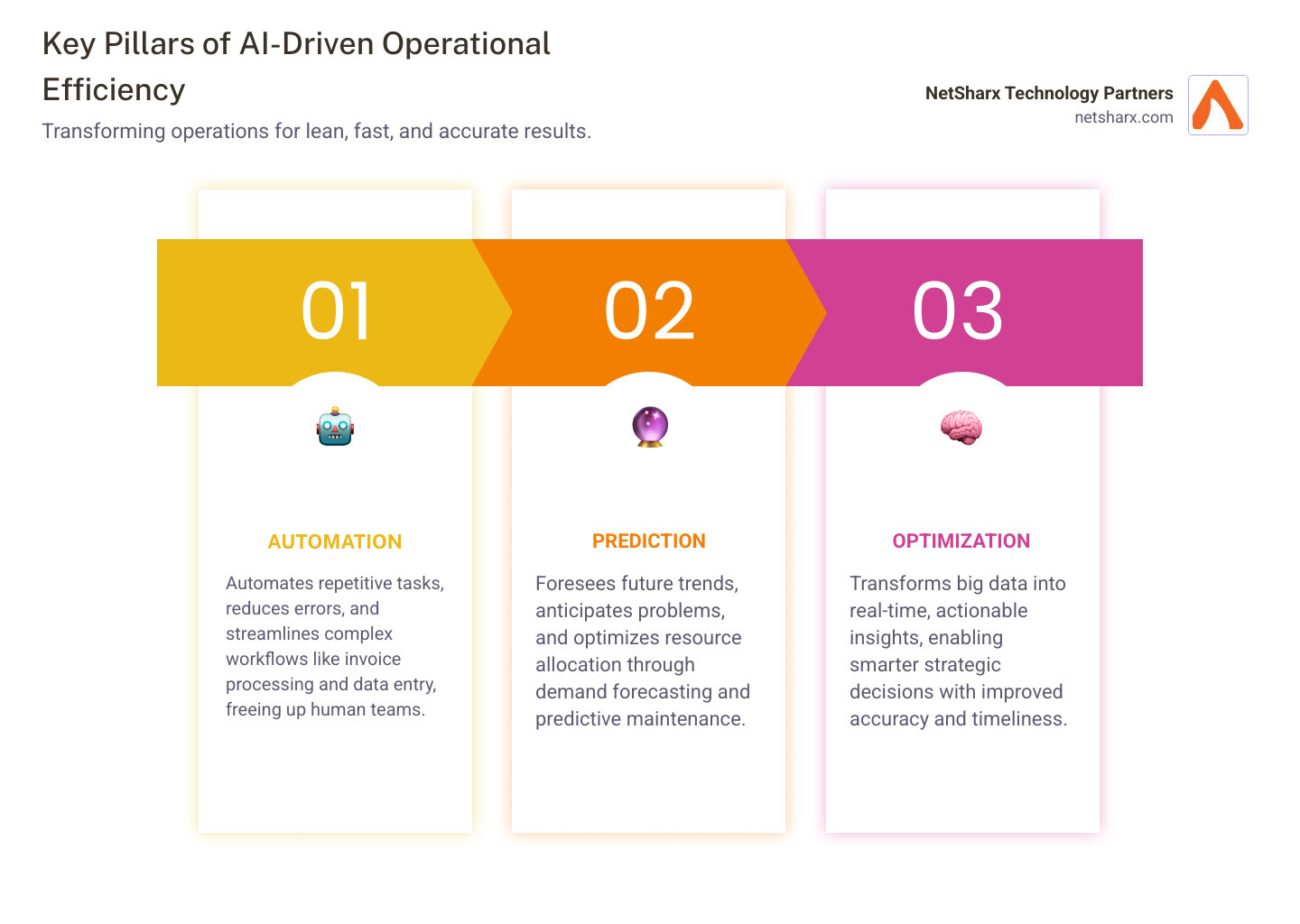AI for operational efficiency: Maximize 2025 Success
The Power of AI for Operational Efficiency
In today’s business world, using AI for operational efficiency is a game-changer for companies looking to do more with less. Faced with constant pressure to cut costs and streamline complex systems, businesses are turning to Artificial Intelligence (AI) for a powerful solution. AI helps you move from simply doing things to doing things better by automating tasks, predicting trends, and turning complex data into actionable insights.
Think of it this way: what the steam engine did for physical labor, AI is doing for intellectual work. As Aidan Gomez, CEO of Cohere, puts it: “What the steam engine did for mechanical work, mechanical labor, this technology (AI) is going to do for intellectual labor.”
This isn’t just hype. With ninety-four percent of business leaders seeing AI as critical to their success over the next five years, it’s clear that AI is a strategic necessity. It helps you automate tedious tasks, predict future challenges, and make smarter decisions based on real data, making your operations leaner, faster, and more accurate.
This guide will show you how. We’ll explore the core ways AI improves efficiency, look at real-world examples, and provide a clear roadmap for bringing AI into your business.
I’m Ryan Carter, CEO of NetSharx Technology Partners. My team and I focus on helping businesses like yours achieve digital change, leveraging AI for operational efficiency to streamline processes and reduce costs across their cloud and network infrastructure.
AI for operational efficiency terms simplified:
The Core Mechanisms: How AI Transforms Business Operations
At its heart, AI for operational efficiency helps your business do more with the resources you already have. It makes your operations smarter, faster, and more budget-friendly. Core technologies like machine learning, Natural Language Processing (NLP), and computer vision are the building blocks that fundamentally change how work gets done. By using them, we can fine-tune processes, cut costs, and see significant jumps in productivity.
Let’s break down these AI superpowers:
- Machine Learning (ML): This is the engine of modern AI, enabling systems to learn from data and improve over time without being explicitly programmed. ML comes in several forms: Supervised Learning uses labeled data to make predictions (e.g., classifying emails as spam or not spam); Unsupervised Learning finds hidden patterns in unlabeled data (e.g., segmenting customers into distinct groups based on purchasing behavior); and Reinforcement Learning trains models to make a sequence of decisions by rewarding desired outcomes (e.g., optimizing dynamic pricing in real-time).
- Natural Language Processing (NLP): This gives computers the ability to understand, interpret, and generate human language. Beyond simple chatbots, NLP powers sophisticated applications like sentiment analysis of customer reviews to gauge brand perception, automated summarization of lengthy reports, and topic modeling of support tickets to identify recurring product issues.
- Computer Vision: This technology allows AI to interpret and understand the visual world. In operations, this translates to systems that can perform quality control on an assembly line with superhuman accuracy, monitor a construction site for safety compliance (like hard-hat detection), or analyze satellite imagery to predict crop yields.
To learn more about how these tools can transform your operations, check out our insights on AI-driven business solutions.
Intelligent Automation: From Repetitive Tasks to Complex Workflows
One of the quickest ways AI for operational efficiency helps is through intelligent automation. This combines Robotic Process Automation (RPA) with AI to handle not just simple, rule-based tasks but also more complex workflows that require judgment.
Think about time-consuming tasks like data entry, invoice handling, or report generation. RPA “bots” can mimic human actions on a computer with incredible speed and accuracy. For example, management reports that took days can be done in an hour, and travel expense reports that took three hours can be finished in just 10 minutes. This frees your team from tedious labor to focus on more creative, customer-focused work.
Beyond individual tasks, AI-driven automation is revolutionizing IT operations through AIOps (AI for IT Operations). This approach uses AI to ingest and analyze massive volumes of data from various IT monitoring tools. It automatically correlates alerts, identifies the root cause of an issue (instead of just flagging dozens of related symptoms), and can even trigger automated remediation scripts. For instance, appliance maker Electrolux used AIOps to cut IT issue resolution time from three weeks to just one hour, saving over 1,000 hours annually. This shows how AI can prevent minor IT glitches from becoming major operational headaches.
Tasks perfect for AI automation include:
- Invoice processing, three-way matching, and payment authorization
- Customer data entry, validation, and updates across multiple systems
- Automated generation of daily, weekly, and monthly performance reports
- Employee onboarding and offboarding workflows, including account provisioning and de-provisioning
- Tier-1 customer service inquiries via intelligent chatbots and voicebots
- Real-time inventory tracking, demand forecasting, and automated reordering
- IT service desk ticket routing and resolution
- Compliance checks and audit trail generation
Predictive Analytics: Foreseeing Trends and Preventing Problems
Another powerful aspect of AI for operational efficiency is predictive analytics. This shifts your business from reacting to problems to proactively anticipating them, saving money and improving reliability. AI analyzes historical and real-time data to find patterns and predict future outcomes with impressive accuracy.
Consider demand forecasting. AI-powered tools can analyze sales data, seasonality, market trends, and even weather forecasts to reduce forecasting errors by up to 50% and cut lost sales from stockouts by up to 65%. This helps businesses maintain optimal inventory levels, satisfying customers without incurring high storage costs.
Predictive maintenance is another area where AI shines. By monitoring data from IoT sensors on equipment, AI can predict when a part is likely to fail before a breakdown occurs. A mining company used this approach to achieve a 30% drop in production downtime. This proactive strategy prevents costly, unplanned stoppages, extends equipment life, and improves worker safety.
At NetSharx, our expertise in AI for network management uses predictive analytics to foresee network issues, optimize data flow, and ensure smooth connectivity, preventing problems before they impact your operations.
Data-Driven Decision-Making: Turning Insights into Action
In an era of “Big Data,” making smart, quick decisions is crucial for AI for operational efficiency. AI excels at processing vast amounts of structured and unstructured data to uncover hidden patterns and provide real-time insights that would be impossible for humans to find alone.
A prime example is JPMorgan’s Contract Intelligence (COiN) system. It analyzes complex commercial credit agreements in seconds, a task that previously took 360,000 hours of manual work annually. This isn’t just about speed; it’s about freeing skilled professionals to focus on high-value strategic work like client negotiation and risk assessment. As CEO Jamie Dimon stated, “This is not hype. This is real.”
This ability to process data means decisions are more accurate and timely. AI can help find hidden correlations (e.g., how a marketing campaign in one region affects supply chain logistics in another), test thousands of operational scenarios simultaneously, and provide decision-makers with optimized solutions, boosting your organization’s capabilities and empowering employees with clear, actionable information.
Real-World Impact: AI for Operational Efficiency Across Industries
While the theory is compelling, the real-world impact of AI for operational efficiency is even more powerful. Businesses across numerous industries are using AI as a practical tool to gain a competitive edge, boost ROI, and transform their operations. Let’s explore some key examples.
Revolutionizing Retail and E-commerce
Retail has eagerly adopted AI for operational efficiency to improve shopping experiences and streamline every aspect of its operations.
- Supply Chain and Forecasting: Walmart uses AI to analyze sales data, weather patterns, and local events to predict product demand with high accuracy, helping them avoid stockouts and overstocking. Learn more about Walmart’s AI-improved workflows.
- Personalized Shopping: Amazon’s recommendation engine, responsible for a significant portion of its sales, uses AI to suggest products custom to individual users. Similarly, Tesco analyzes Clubcard data to offer Tesco’s personalized promotions, increasing customer loyalty and purchase frequency.
- In-Store Analytics: Computer vision cameras analyze foot traffic to optimize store layouts, identify popular product displays, and manage queue lengths at checkout, improving the physical shopping experience.
- Fraud Detection: Alibaba uses AI to analyze billions of transactions in real-time, flagging potentially fraudulent activity with incredible precision. In physical stores, AI cameras at self-checkouts can detect when an item isn’t scanned correctly, helping to prevent theft.
- Dynamic Pricing: Airlines and e-commerce sites use AI to adjust prices dynamically based on real-time demand, competitor pricing, and inventory levels, maximizing revenue on every flight or product.
Changing Finance and Banking
The finance industry is a perfect fit for AI for operational efficiency due to its vast data volumes, stringent regulations, and need for high security.
- Process Automation: JPMorgan’s COiN system reviews complex credit agreements in seconds, saving 360,000 hours of work annually. This allows legal and financial experts to focus on higher-value analysis.
- Algorithmic Trading: Hedge funds and investment banks use AI to analyze market data at speeds no human can match, executing trades based on complex predictive models to capitalize on fleeting market opportunities.
- Customer Service: Axis Bank’s AI voicebot, AXAA, handles a large volume of customer calls with over 90% accuracy, freeing up human agents for more complex, empathetic customer issues. Learn about Axis Bank’s AXAA voicebot.
- Fraud Detection and Cybersecurity: AI analyzes transaction patterns to detect anomalies that signal fraud in real-time. A full 91% of financial firms are now using or testing AI, with cybersecurity being a primary use case, as highlighted in our expertise on AI-Based Cybersecurity Tools.
Advancing Healthcare Operations
Healthcare is using AI for operational efficiency to streamline its complex processes, reduce costs, and improve patient outcomes.
- Administrative Efficiency: AI helps hospitals automate patient scheduling, manage medical records, and streamline the billing and claims process, reducing administrative errors and costs. Cleveland Clinic uses an AI-driven portal to guide patients through the healthcare system.
- Resource Allocation: By analyzing historical admission data and local health trends, AI can predict patient influx, helping hospitals optimize staffing schedules and bed assignments. Cleveland Clinic’s Center for Clinical Artificial Intelligence is a leader in this area, improving both patient outcomes and financial health.
- AI-Assisted Diagnostics: AI algorithms can analyze medical images like X-rays, MRIs, and CT scans to detect signs of disease, such as cancerous tumors, often with greater accuracy than the human eye, serving as a powerful tool for radiologists.
- Improved Patient Care: By automating routine administrative tasks, AI reduces the burden on caregivers, allowing them to spend more quality time with patients. This not only improves the patient experience but also helps prevent clinician burnout.
Optimizing the Supply Chain and Manufacturing
Manufacturing and supply chains are realizing huge cost savings and reliability gains from AI for operational efficiency.
- Inventory Management: IBM saved $160 million and achieved a 100% order fulfillment rate by using AI-driven solutions to gain end-to-end visibility into its own complex supply chain.
- Quality Control: AI-based visual inspection systems on production lines can outperform humans. One auto manufacturer’s AI system identified paint defects with 97% accuracy, compared to 70% for human inspectors, reducing rework costs.
- Predictive Maintenance: AI analyzes sensor data from factory machinery to predict equipment failure before it happens, allowing for scheduled maintenance that prevents costly, unplanned downtime.
- Logistics and Waste Reduction: AI optimizes transportation routes in real-time based on traffic and weather, designs more efficient warehouse layouts, and fine-tunes production schedules to minimize wasted time, energy, and materials. Our Network Optimization Services help ensure your underlying networks can support these data-intensive operations.
Changing Human Resources
AI is also revolutionizing HR by automating administrative tasks and providing data-driven insights into the workforce.
- Talent Acquisition: AI-powered tools can screen thousands of resumes in minutes, ranking candidates based on how well their skills and experience match a job description. This accelerates the hiring process and helps reduce unconscious bias.
- Employee Engagement: NLP can analyze anonymized feedback from employee surveys and internal communication platforms to gauge overall sentiment, identify common concerns, and predict attrition risks, allowing management to intervene proactively.
- Personalized Development: AI platforms can act as a career coach, recommending personalized training modules, learning resources, and potential career paths to employees based on their role, performance, and stated goals.
A Strategic Blueprint: A Practical Guide to AI Implementation
Implementing AI for operational efficiency is a strategic journey, not a one-off IT project. It requires careful planning, a phased approach, and a commitment to continuous improvement. At NetSharx Technology Partners, our expertise in Digital Change Consulting helps guide you through this change, ensuring you get maximum value from your investment.
Step 1: Define Clear Business Objectives and Identify Use Cases
The first step is always to ask, “Why?” Before adopting any technology, you must pinpoint the specific business problems you want to solve. Are you trying to reduce invoice processing time by 50%, cut operational costs in the supply chain by 15%, or improve customer first-contact resolution rates? By tying AI for operational efficiency to clear, quantifiable business goals, you ensure your investment delivers measurable results.
Start by assembling a cross-functional team or “AI Council” to brainstorm potential use cases. Evaluate each idea on an impact/effort matrix: which projects offer the highest business value for the lowest implementation complexity? Focus on these “low-hanging fruit” first. These early wins are crucial for building momentum, securing executive buy-in, and demonstrating the tangible value of your AI initiatives, as noted by Gartner research.
Step 2: Assess Data Readiness and Infrastructure
AI thrives on high-quality, relevant data. The principle of “garbage in, garbage out” is especially true for AI models. Before deployment, you must conduct a thorough assessment of your data landscape.
- Data Strategy: Do you have a formal data governance framework that defines how data is collected, stored, accessed, and secured? Is your data accurate, complete, and consistent across different systems?
- Data Preparation: Most real-world data is messy. You will need processes for data cleansing (handling missing values and correcting errors), integration (combining data from different sources), and labeling (tagging data for supervised learning models).
- Infrastructure: Do you have the necessary infrastructure to support AI workloads? This often means leveraging scalable cloud computing platforms for storage (like data lakes) and processing power (like GPUs). At NetSharx, we specialize in cloud and network solutions, ensuring your infrastructure is robust, secure, and ready to support your AI goals.
Without a solid data foundation, even the most advanced AI algorithm will fail.
Step 3: Foster an AI-Ready Culture and Upskill Your Team
Technology alone can’t deliver AI for operational efficiency if your people aren’t prepared and on board. Successful AI adoption is as much about change management as it is about technology.
- Communicate the Vision: It’s critical to frame AI as a tool that augments human capabilities, not one that replaces jobs. Communicate a clear vision of human-AI collaboration, where AI handles the repetitive, data-heavy work, freeing up your team for strategic thinking, creativity, and complex problem-solving.
- Invest in Training: Build the skills needed to work alongside AI. This means more than just hiring data scientists. You need to raise your entire organization’s AIQ (Artificial Intelligence Quotient). This includes data literacy programs for managers, analytics training for business users, and specialized upskilling for IT staff. Consider creating an AI “Center of Excellence” (CoE) to centralize expertise and provide support across the organization.
- Encourage Experimentation: Foster a culture that is open to experimentation and learning from failure. Start with pilot programs in friendly departments, celebrate successes publicly, and use those wins to build a case for broader adoption. This shift is not about eliminating jobs but evolving roles for a transformed, more efficient workplace.
Step 4: Measure Success: How to Quantify the Impact of AI for Operational Efficiency
To justify your investment and continuously improve, you must track Key Performance Indicators (KPIs) from the start. Measuring impact allows you to calculate your Return on Investment (ROI) and refine your strategy over time.
Go beyond high-level metrics and track specific, relevant KPIs for each use case:
- Cost Savings: Reduction in cost-per-transaction, lower equipment maintenance expenses, decreased overtime hours, reduced spending on outsourced services.
- Productivity Gains: Faster cycle times (e.g., order-to-cash), increased output per employee, higher number of customer cases resolved per agent, reduced time-to-market for new products.
- Error Rate Reduction: Fewer mistakes in data entry, lower percentage of billing errors, improved compliance audit scores, reduction in manufacturing defects.
- Customer and Employee Metrics: Improved Customer Satisfaction (CSAT) scores, higher Net Promoter Score (NPS), faster customer response times, increased employee retention rates in augmented roles.
As a CIO article on measuring AI impact suggests, you can use A/B testing to compare the performance of an AI-powered process against the traditional baseline. This provides concrete evidence of AI’s contribution to overall performance and helps secure funding for future projects.
Navigating the Problems: Challenges and Ethics in AI
While the promise of AI for operational efficiency is immense, it’s important to be realistic. AI is not a magic bullet; it comes with its own set of challenges and ethical considerations that must be managed proactively to avoid wasted investment, reputational damage, or legal issues.
Overcoming Common Implementation Challenges
Bringing AI into your business often involves navigating a few common problems:
- Data Security and Privacy: AI systems often require access to vast amounts of sensitive customer and business data. This makes them a prime target for cyberattacks. You must implement robust cybersecurity measures, including end-to-end encryption and strict access controls, and ensure compliance with data privacy regulations like GDPR and CCPA.
- Integration with Legacy Systems: Many organizations run on older IT infrastructure that wasn’t designed for modern AI. Connecting new AI tools with these legacy systems can be complex and costly. A strategy using APIs (Application Programming Interfaces) and a microservices architecture can help bridge this gap without requiring a complete overhaul.
- High Initial Costs and ROI Uncertainty: The initial investment in technology, infrastructure, and specialized talent can be significant. It can also be difficult to predict the exact ROI of an AI project. Careful budget planning, starting with smaller pilot projects with clear metrics, and focusing on high-value use cases are key. Our insights on Showing the Secrets of Cutting Technology Costs can help.
- Talent Shortage: There is a high demand and limited supply of skilled AI professionals like data scientists and machine learning engineers. This makes it challenging and expensive to build an in-house team. Many businesses address this by upskilling their existing workforce and partnering with external experts.
- Model Drift and Maintenance: An AI model is not a one-time setup. Its performance can degrade over time as real-world data patterns change—a phenomenon known as “model drift.” Models require continuous monitoring, periodic retraining with new data, and ongoing maintenance to remain effective and accurate.
Addressing the Ethical Dimensions of AI for Operational Efficiency
Beyond technical issues, the ethical use of AI for operational efficiency is paramount for building trust and avoiding harm.
- Algorithmic Bias: If an AI model is trained on biased historical data, it can perpetuate and even amplify that bias. For example, an AI recruiting tool trained on past hiring data from a male-dominated company might learn to unfairly penalize resumes from female candidates. As a NIST report on AI bias highlights, mitigating this requires a comprehensive strategy, including bias audits, using fairness-aware algorithms, and ensuring diverse teams build and test the models.
- Transparency and Explainable AI (XAI): For many high-stakes AI decisions, it’s crucial to understand the “why.” In a regulated field like banking, if an AI model denies a loan, the bank must be able to explain its reasoning. XAI is an emerging field that aims to make AI’s decision-making process clear to humans, which is vital for accountability, debugging, and building trust with both users and regulators.
- AI Hallucinations: Generative AI models, like those that power chatbots, can sometimes invent false information that appears credible and authoritative. As AP News on AI falsehoods reports, this makes rigorous human oversight and fact-checking essential, especially when AI is used in customer-facing or decision-making roles, to prevent the spread of misinformation.
- Workforce Impact and Displacement: While AI augments many jobs, it also automates tasks previously done by humans, leading to inevitable workforce shifts. Businesses have an ethical responsibility to manage this transition. This means going beyond simple layoffs and investing in robust retraining and upskilling programs to create clear transition pathways for employees whose roles are most affected, helping them adapt to new, higher-value roles within the organization.
Frequently Asked Questions about AI for Operational Efficiency
Thinking about bringing AI for operational efficiency into your business? It’s natural to have questions. Here are some of the most common ones, answered directly.
What is the first step to using AI for operational efficiency?
The best first step isn’t choosing a technology, but defining your goal. Start by identifying a specific, high-impact business problem or inefficiency you want to solve. Do you want to speed up invoice processing or reduce customer service wait times? By starting with a clear objective, you ensure your AI initiative is aligned with core business goals and provides a clear metric for success. When you start with the “why,” the “what” and “how” become much clearer.
Can small businesses benefit from AI, or is it just for large enterprises?
Absolutely. While large enterprises make headlines, AI for operational efficiency is now highly accessible for small and medium-sized businesses (SMBs). Thanks to cloud computing and “AI-as-a-Service” (AIaaS) platforms, you don’t need a massive budget or an in-house team of data scientists. SMBs can easily leverage AI for customer service chatbots, marketing automation, or inventory forecasting on a pay-as-you-go basis, making it a game-changer for businesses of all sizes.
Will AI replace human jobs in operations?
The conversation is shifting from AI replacing humans to AI augmenting them. AI is excellent at handling repetitive, rule-based tasks like data entry, which frees up your team to focus on what humans do best: strategic thinking, creative problem-solving, and building relationships. The most successful organizations accept this human-AI collaboration. They view AI as a powerful partner that handles the operational heavy lifting, allowing their human employees to drive value in more strategic ways. It’s about working smarter, not just harder.
Conclusion
Embracing AI for operational efficiency is no longer just an option; it’s a strategic imperative. We’ve seen how AI’s power—through intelligent automation, predictive analytics, and data-driven decision-making—can streamline operations, reduce costs, and boost productivity across all industries. From retail and finance to healthcare and manufacturing, AI is fundamentally reshaping how business gets done.
However, AI is not a magic wand. Successful implementation requires a clear strategy, quality data, a team prepared for change, and robust methods for measuring impact. It also demands that we address the associated challenges and ethical questions head-on, ensuring AI is deployed responsibly and fairly.
The AI journey can seem complex, but you don’t have to steer it alone. That’s where we, NetSharx Technology Partners, come in. With our comprehensive support and unbiased, agnostic advice, we simplify this technological change. Whether you need help with solution engineering, competitive pricing, or integrating AI with your existing cloud, network, and cybersecurity infrastructure, we are here to ensure you achieve unparalleled operational efficiency.
Just as we help make your Customer Experience Change Simplified, we’re ready to help you steer your AI adoption. The future of business operations is intelligent, and it’s powered by AI.
Find our AI-Improved Communication Tools to start your change journey.







